Breeds of Buffaloes
Breeds of Buffaloes
The buffalo species originated in India. The present day domesticated buffaloes are the descendants of Bos arni found in wild state even today in north-eastern parts of India specially Assam and the surrounding areas. The buffaloes are normally classified into river ad swamp types though both are called Bubalus bublis. Most of the animals in India re river type though swamp type are also found in certain parts of the country specially in eastern parts of India.
India is considered as the home tract of some of the best buffalo breeds. Because of preference of buffaloes for milk, many she buffaloes from the breeding tract are moved to the thickly populated urban and industrial centre for meeting the milk requirements of this population. Here generally they are slaughtered after completion of one or two lactation. Their progenies allowed to die due to neglect and thus no replacement of superior germplasm is possible.
Indian buffaloes are in important source of milk supply today and yield nearly three times as much milk as cows. More than half of the total milk produced (55%) in the country was contributed by the 47.22 million milch buffaloes, where as the 57.0 million cows contribute only 45% of the total milk yield. Indian Buffaloes are water buffaloes. There are about 10 indigenous standard breeds of buffaloes, which are well known for their milking qualities.
MURRAH
- It is the most important breed of buffaloes whose home is Rohtak, Hisar and Jind of Haryana and Nabha and Patiala districts of Punjab.
- Synonyms : Delhi, Kundi, Kali
- The colour is usually jet black with white markings on tail and face and extremities sometimes found.
- The tightly curved horn is an important character of this breed.
- The body size is massive, neck and head are comparatively long.
- Head of females is short, fine and clear cut.
- Hips are broad and fore and hind quarters are drooping.
- The buffalo cows of this breed are one of the most efficient milk and butter fat producers in India.
- Butter fat content is 7% Average lactation yield is vary from 1500-2500 kg the average milk yield is 6.8 kg/day.
- While a few individual animals yield much as 19.1 kg/day.
- Age at first calving is 45-50 months and inter calving period is 450-500 days.
|
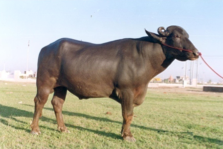
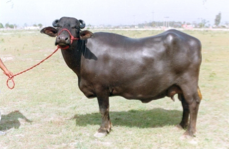 |
TOP |
NILI RAVI
- This breed is found in Sutlej valley in Ferozpur district of Punjab and in the Sahiwal district of Pakistan.
(bred around Ravi river)
- Usually the colour is black with white marking on forehead, face, muzzle, legs and tail.
- The most desired character of the female is the possession of white markings.
- The head is elongate, bulging at top and depressed between eyes. The muzzle is fine.
- The frame is medium sized.
- The peculiarity of the breed is the wall eyes.
- The horns are small and coiled tightly. The neck is long, thin and fine.
- The milk yield is 1500-1850 kg per lactation and the inter calving period is 500-550 days.
- Age at first calving is 45-50 months.
|
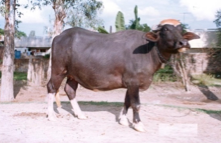
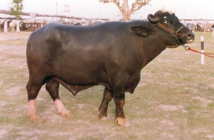 |
BHADAWARI
- Agra and Etawah district of Uttar Pradesh and Gwalior district of Madhya Pradesh.
- The body is medium size and wedge shaped. The head is comparatively small, the legs are short and stout, and the hooves are black. The hind quarters are uniform and higher than the forequarter.
- The body is usually light or copper coloured is a peculiarity of this breed. Eye lids are generally copper or light brown colour.
- Two white lines ‘Chevron’ are present at the lower side of the neck similar to that of surti buffaloes.
- Horns are black, curling slightly outward, downward before running backward parallel and close to neck, and finally turning upward.
- The average milk yield is 800 to 100 kg.
- The bullocks are good draught animal with high heat tolerance.
- The fat content varies from 6 to 12.5 per cent. This breed is an efficient converter of coarse feed into butterfat and is known for it high butter fat content.
|
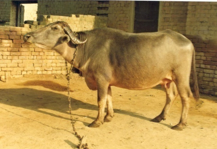
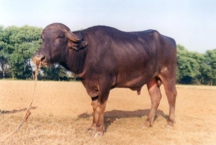 |
JAFFARABADI
- These are massive animals found in their pure form in Gir forests. The breeding tract of this breed is Kutch, and Jamnagar districts of Gujarat.
- The head and neck are massive. The forehead is very prominent, wide with a slight depression in the middle.
- The horns are heavy, inclined to droop at each side of the neck and then turning up at point, but les tightly curved than in Murrah (drooping horns).
- The colour is usually black.
- The average milk yield is 100 to 1200 kg. These animals are mostly maintined by traditional breeders called Maldharis, who are nomads.
- The bullocks are heavy and used for ploughing and carting.
|
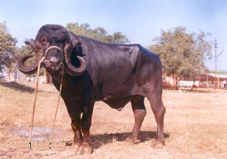
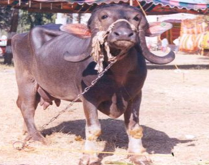 |
TOP |
SURTI
- The breeding tract of this breed is Kaira and Baroda district of Gujarat.
- Coat colour varies from rusty brown to silver-grey. Skin is black or brown.
- The body is well shaped and medium sized; the barrel is wedge shaped.
- The head is long with prominent eyes.
- The horns are sickle shaped, moderately long and flat.
- The colour is black or brown
- The peculiarity of the breed is two white collars, one round the jaw and the other at the brisket.
- The milk yield ranges from 900 to 1300 kg.
- The age at first calving is 40-50 months with a intercalving period of 400-500 days.
- The peculiarity of this breed is very high fat percentage in milk (8-12per cent).
|
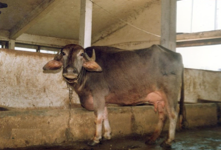
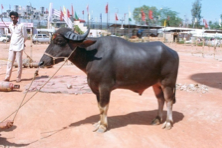 |
MEHSANA
- Mehsana is a dairy breed of buffalo found in Mehsana town in Gujarat and adjoining Maharastra state.
- Body is mostly black; a few animals are black-brown in colour.
- The breed is supposed to have been evolved out of crossbreeding between the Surti and the Murrah.
- The body is longer than in Murrah and the limbs lighter.
- The head is longer and heavier.
- The horns usually are less curved at the end compared to Murrah breed but are longer and could be of irregular shape.
- The milk yield is 1200-1500 kg.
- The breed is supposed to have good persistency.
- The intercalving period ranges between 450-550 days.
|
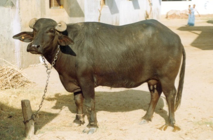
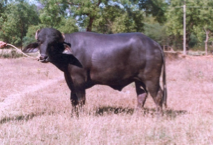 |
NAGPURI (OR) ELLICHPURI
- The breeding tract of this breed is Nagpur, Akola and Amrawati districts of Maharashtra.
- These are black coloured animal with white patches on face, legs and tail.
- This is also called as Elitchpuri or Barari.
- The horns are long, flat and curved, bending backward on each side of the back almost to shoulder
(sward shaped horns).
- Horns of this type have a distinct advantage that they help the animals to protect themselves from wild animals and also easy to move in the forest.
- The face is long and thin. The neck is somewhat long.
- The average milk yield is 700-1200 kg per lactation.
- The age at first calving is 45-50 months with an inter-calving period of 450-550 days.
|
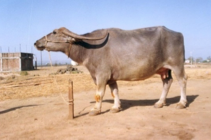
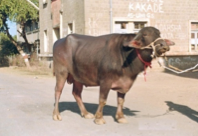 |
TOP |
GODAVARI
- Godavari is a result of crossing of native buffaloes with Murrah bulls. The home tract is Godavari and Krishna deltaic area
- The animals are of medium stature with compact body. The colour is predominantly black with a sparse coat of coarse brown hair.
- Godavari buffaloes are reputed for high fat with daily average milk yield of 5-8 litres and lactation yield of 1200-1500 litres.
- The animals breed regularly and have a short calving interval compared to Murrah.
|
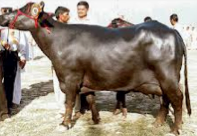 |
|
TODA
- Toda breed of buffaloes is named after an ancient tribe, Toda of Nilgiris of south India.
- Coat colour of the calf is generally fawn at birth.
- In adult the predominate coat colours are fawn and ash-grey.
- These buffaloes are quite distinct from other breeds and are indigenous to Nilgiri hills.
- The animals have long body, deep and broad chest, and short and strong legs.
- The head is heavy with horns set well apart, curving inward outward and forward.
- Thick hair coat is found all over the body. They are gregarious in nature.
|
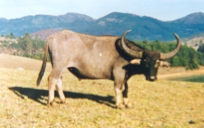 |
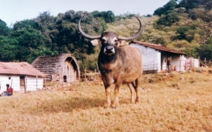 |
|
PANDHARPURI
- Native of Kolhapur, Solapur districts in south Maharashtra.
- Body colour varies from light black to deep black.
- It is medium sized animal having long narrow face, very prominent and straight nasal bone, comparatively narrow frontal bone and long compact body.
- Typical characteristic of this breed is its horns which are very long, curved backward, upward and usually twisted outwards. The horns are very long extending beyond shoulder blade, sometimes up to pin bones
|
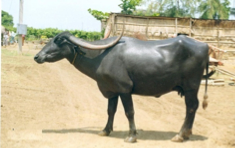 |
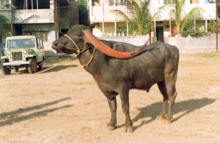 |
|
TOP |
Source:
Dr. R. Mathivanan
Professor and Head,
Department of Animal Husbandry and Veterinary Science,
Tamil Nadu Agricultural University, Coimbatore - 3
|



















